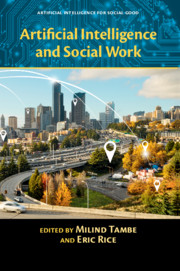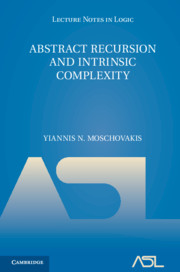Refine search
Actions for selected content:
48287 results in Computer Science
Index
-
- Book:
- Artificial Intelligence and Social Work
- Published online:
- 24 November 2018
- Print publication:
- 29 November 2018, pp 255-258
-
- Chapter
- Export citation
2 - The Causes and Consequences of Youth Homelessness
- from Part I
-
- Book:
- Artificial Intelligence and Social Work
- Published online:
- 24 November 2018
- Print publication:
- 29 November 2018, pp 16-37
-
- Chapter
- Export citation
Glossary
-
- Book:
- Artificial Intelligence and Social Work
- Published online:
- 24 November 2018
- Print publication:
- 29 November 2018, pp 250-254
-
- Chapter
- Export citation

Artificial Intelligence and Social Work
-
- Published online:
- 24 November 2018
- Print publication:
- 29 November 2018

Abstract Recursion and Intrinsic Complexity
-
- Published online:
- 23 November 2018
- Print publication:
- 06 December 2018
RSL volume 11 issue 4 Cover and Front matter
-
- Journal:
- The Review of Symbolic Logic / Volume 11 / Issue 4 / December 2018
- Published online by Cambridge University Press:
- 23 November 2018, pp. f1-f4
- Print publication:
- December 2018
-
- Article
-
- You have access
- Export citation
RSL volume 11 issue 4 Cover and Back matter
-
- Journal:
- The Review of Symbolic Logic / Volume 11 / Issue 4 / December 2018
- Published online by Cambridge University Press:
- 23 November 2018, pp. b1-b2
- Print publication:
- December 2018
-
- Article
-
- You have access
- Export citation
Iris from the ground up: A modular foundation for higher-order concurrent separation logic
- Part of
-
- Journal:
- Journal of Functional Programming / Volume 28 / 2018
- Published online by Cambridge University Press:
- 22 November 2018, e20
-
- Article
-
- You have access
- Open access
- Export citation
A review of learning planning action models
-
- Journal:
- The Knowledge Engineering Review / Volume 33 / 2018
- Published online by Cambridge University Press:
- 21 November 2018, e20
-
- Article
- Export citation
How participative is open source hardware? Insights from online repository mining
- Part of
-
- Journal:
- Design Science / Volume 4 / 2018
- Published online by Cambridge University Press:
- 21 November 2018, e19
-
- Article
-
- You have access
- Open access
- HTML
- Export citation
Choosing the number of groups in a latent stochastic blockmodel for dynamic networks
-
- Journal:
- Network Science / Volume 6 / Issue 4 / December 2018
- Published online by Cambridge University Press:
- 15 November 2018, pp. 469-493
-
- Article
- Export citation
Introducing Computer Science to High School Students Through Logic Programming
-
- Journal:
- Theory and Practice of Logic Programming / Volume 19 / Issue 2 / March 2019
- Published online by Cambridge University Press:
- 14 November 2018, pp. 204-228
-
- Article
- Export citation
onlineSPARC: A Programming Environment for Answer Set Programming
-
- Journal:
- Theory and Practice of Logic Programming / Volume 19 / Issue 2 / March 2019
- Published online by Cambridge University Press:
- 14 November 2018, pp. 262-289
-
- Article
- Export citation
Web-STAR: A Visual Web-based IDE for a Story Comprehension System
-
- Journal:
- Theory and Practice of Logic Programming / Volume 19 / Issue 2 / March 2019
- Published online by Cambridge University Press:
- 14 November 2018, pp. 317-359
-
- Article
- Export citation
PES volume 32 issue 4 Cover and Back matter
-
- Journal:
- Probability in the Engineering and Informational Sciences / Volume 32 / Issue 4 / October 2018
- Published online by Cambridge University Press:
- 13 November 2018, pp. b1-b2
-
- Article
-
- You have access
- Export citation
Parberry’s pairwise sorting network revealed
- Part of
-
- Journal:
- Journal of Functional Programming / Volume 28 / 2018
- Published online by Cambridge University Press:
- 13 November 2018, e21
-
- Article
-
- You have access
- Export citation
PES volume 32 issue 4 Cover and Front matter
-
- Journal:
- Probability in the Engineering and Informational Sciences / Volume 32 / Issue 4 / October 2018
- Published online by Cambridge University Press:
- 13 November 2018, pp. f1-f2
-
- Article
-
- You have access
- Export citation
ITERATED FAILURE RATE MONOTONICITY AND ORDERING RELATIONS WITHIN GAMMA AND WEIBULL DISTRIBUTIONS – CORRIGENDUM
-
- Journal:
- Probability in the Engineering and Informational Sciences / Volume 32 / Issue 4 / October 2018
- Published online by Cambridge University Press:
- 13 November 2018, pp. 640-641
-
- Article
-
- You have access
- Export citation


